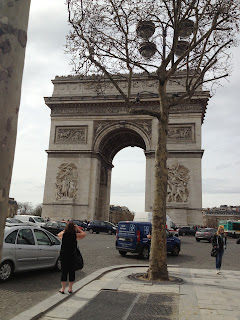16 April 2013
“Le ciel cassé est poignardé par l’Eiffel. Il sainge blanche.”
“Le ciel cassé est poignardé par l’Eiffel. Il sainge blanche.”
“The broken sky is stabbed by the Eiffel.
It bleeds white.”
Rise. The french dawn shatters through our
window, laying its sheen on our scattered bodies like spilled red wine. We find
ourselves at the mercy of another tumultuous day of Parisian life.
The dawn lingers for the morning, then
fades. The group surges forward, voyaging through the Métro of Paris like a
swarm of locusts devouring the city. We descend upon the tower.
The Tower.
The Tower was uncapturable. Mere photos do
not capture its sheer, indescribable majesty. It laughs at our pitiful attempts
at the novelty of souvenir, our quest for a photo that replaces the experience
itself. It demands our attention, our undivided attention, stretching out our
bodies and pulling our eyes ever upwards along its length. It is
uncomprimising. How can man build such an imposing structure when our best
efforts to describe it fall immesurably short? The only way the Eiffiel Tower
can be captured is locked in the innermost memories of those who have dared to
stand beneath its raw iron. The Eiffiel Tower is a feeling. Our impotence and
our quest for immortality.
Those who summit the Tower escape those
feelings, if only for a breif moment. Paris lies splayed beneath our feet. Her
beauty is revealed in a burst of detail, too insurmountable to recognise in a
glance. But when one stands there, lost in the hazy ash of the Parisian
skyline, Paris surrenders. Slowly, one allows the sight to permeate the lining
of the mind. We drop our guard to the breathtaking complexity of Paris. One
realises that it is not the great monuments that make Paris so marvellous. It
is the streets paved with art. Almost accidental art. Art is so imbued within
Paris that walls become a canvas. Looking out at the city, one realises this.
For the most beautiful view of Paris is the one without its greatest monument.
To dislike the Eiffiel Tower on grounds of symbolic insensitivity is a mere
phallicy.
L’Arc du Triumph is a stone that glowers.
It is unmovable. Implacable. It stands as the heart of Paris, with the traffic
flowing around it, and it casts its stony visage into every person’s soul.
L’Arc du Triumph is a study in duality. The duality between plain strength and
ornate, fragile beauty. The vast stone frame soars above the city. Square and
powerful, it is a symbol of the stoic nature of the French military. But within
this imposing structure lies the gentle arches, the voluptuous curves of une
fille du Francais. The sharp, precise, and utterly convoluted statues are
breath taking in the simplicity of their making. Not gleaming with bright gold,
but worked out of cold, unliving stone. L’Arc du Triumph is the monument to our
immortality. It thrusts into the sky with arrogance. And it is beautiful,
because it displays the vulnerability of our egos.
A key facet of our life in Paris was le
Métro.
“Les ponts du ciel. Au desus des trottoirs,
ils restent sur le visage de la ville, ménacant en ferre.”
On le Métro, we glided over the the city as
if our shoes were rings of rubber and steel. At first we traveled together,
the discordant clangs of the ruthless, careless English tossed out by hooligans
crushing the delicate web of words, but once alone, the lilting strains of the
french language washed over us and we drank it as though it was the nectar of
all knowledge. Appreciation is born of silence. And we were silent. And we
listened. We listened with such ferocity that our ears distended, we listened
with the intensity of a manic stare, we listened. We attempted to beat French
into submission, to pin down the vagaries shove them into boxes, ravish them
of their mystery, until it overwhelmed us. Then we just listened. French can’t
be forced.
By Daniel and Will




No comments:
Post a Comment